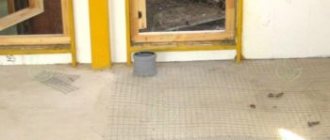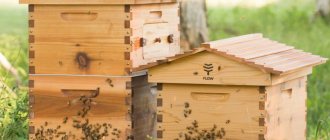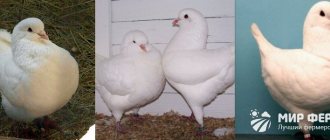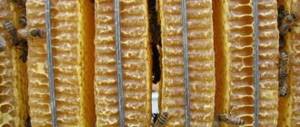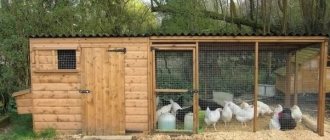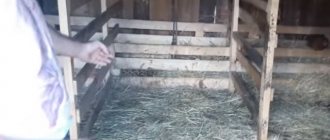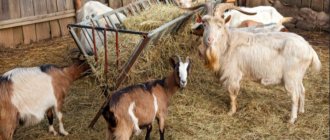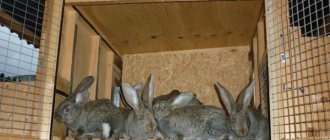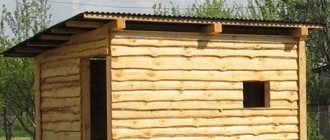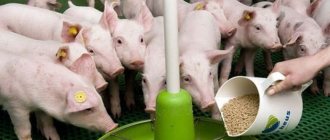Modern livestock farms are complex to implement, but well-functioning and high-quality operating systems. Slotted floors played a significant role in simplifying the process of raising livestock. They represent a convenient covering through which a self-floating system for manure intake is carried out. Thanks to this, the quality indicators of the livestock farm increase significantly. Slotted floors are often used for raising cattle and pigs. You will learn the features of choosing, creating and installing slatted floors for pigsties in this article.
Structural diagram of slatted floors
What are slatted floors and why are they needed?
Slotted floors usually mean complex engineering structures consisting of two levels. The first is allocated for organizing living space for pigs. The second is used for manure removal. For this purpose, baths are specially created, as well as channels through which waste products of pigs are collected.
Appearance of slatted floors
Coverings in the form of slatted floors can be made from several types of materials. The most popular at the moment are decking made from concrete, iron or a specialized type of plastic. Suitable material is selected depending on the purpose of use. For the covering, slabs with slots are used, the width of which ranges from 1 to 2 cm. Manure is removed through these holes.
Why is it beneficial to install slot covering?
Unlike solid flooring, which until recently was ubiquitous, slotted flooring has a number of major advantages. Let's take a closer look at them.
Location of slatted floors
- Thanks to the use of slatted floors, much less effort is spent on maintaining the health of animals. Despite the fact that intestinal and cold diseases are almost inevitable on pig farms, their number is quite low, and the course time is shortened compared to a continuous coating;
- Indicators of daily weight gain for one individual are important. And if there is a slatted floor on the farm, the amount of weight gain increases. For growing livestock it is 50 grams, and for those pigs that need to be fattened - 80 g;
- The use of slotted covering reduces energy costs by almost half;
- In addition to electricity, the amount of water needed to clean the pens of manure is also reduced. Water supply will be required 5 times less;
- Certain types of slatted floors are created not only in production, but also with your own hands. This is especially true when you plan to create a small farm.
Types of slatted floors for pigsties
Depending on what animals need to be kept in the enclosure, it is necessary to install a slatted floor made of one material or another. As mentioned above, there are three options to choose from.
Concrete slatted floors
Slabs made of concrete or reinforced concrete are more often used in large livestock farms because they can withstand large weight loads. But they are not suitable for small private pig farms. This is explained by the positive and negative characteristics of the sexes.
Structure of concrete slatted floors
What characteristics will be useful to breeders:
- increased strength compared to other types of slatted floors. Since reinforced concrete is the strongest of the materials presented, it is durable, reliable and can last up to 20 years;
- Concrete slabs, unlike wood, do not absorb odors due to their fine porous structure;
- Resistant to wear even under prolonged and high mechanical stress.
Disadvantages of using reinforced concrete slabs:
- reinforced concrete slatted floor is in a higher price category, and its installation requires a lot of effort and time. This is explained by the fact that in most cases installation requires qualified specialists and special construction equipment;
- It is highly not recommended to keep piglets in pens with concrete slabs at the bottom. According to the advice of veterinarians, such floors are more suitable for keeping and breeding adult animals.
Premises for keeping adult pigs
The note! This type of flooring is ideal for keeping large livestock. Thanks to its wear resistance, it can cope with loads of up to 600 kilograms of weight per 1 square meter. Unfortunately, it is quite difficult to make such a coating yourself, so purchasing ready-made slabs is an alternative option.
Plastic slatted floors
Despite the fact that coverings for pens on pig farms made of plastic have recently become fashionable, many pig barn owners have appreciated the convenience and benefits of using plastic boards. They are cast using industrial equipment. Also, you should not make a large covering from a large number of small slabs. Connections using conventional mechanical installation may result in cracks. In this case, the slab can quickly break under the weight of the animals. And making a plastic plate with your own hands is a complex technological process that is inaccessible in the absence of professional equipment and special forms. Another feature is that part of the future floor is fixed into the slab at the time of casting.
Structure of concrete slatted floors
Let's consider the positive qualities of a plastic slatted floor:
- the main difference is low thermal conductivity. Due to this, the animals will be warm and comfortable during the winter cold. Unlike the reinforced concrete version, it will not require additional heating;
- This floor is very hygroscopic. Does not absorb water and the smell of animal waste products. Easy to clean;
- lower prices compared to concrete or metal slatted floors. The savings extend not only to the manufacture, but also to the installation of the paddock cover;
- expanded range thanks to a large number of specialized companies.
A negative impression can only arise due to the low environmental friendliness of the material. Plastic is not as environmentally friendly as metal, wood or reinforced concrete.
Young pigs feel comfortable on plastic slatted floors
This type of slot covering is deservedly in demand among farmers. In addition to these advantages, it can be noted that the slabs are light in weight, can be provided in almost any configuration and do not require special transport to organize the transportation of this building material. Plastic slatted floors are ideal for raising piglets, both nursery and nursing sows. Grown animals will need to be transferred to other pens, since such slabs are aimed at the average weight of the livestock.
Metal slatted floors
Not the most common floors that are made of metal - galvanized iron - or cast iron. They have a fairly wide list of positive qualities:
- Both metal and cast iron are highly wear-resistant, so they do not wear out for a long time. Practically do not crack;
- metal does not absorb moisture. As a result, you don’t have to worry about the floors absorbing moisture or manure odors;
- cleaning metal slatted floors does not bring much inconvenience;
- One of the main advantages is the ability to make such a coating with your own hands.
Structure of metal slatted floors
However, one should not ignore the disadvantages of the material:
- metal floors, due to the characteristics of the material, are prone to rust;
- Galvanized iron and cast iron have high thermal conductivity, so the floors will be cold and may not be suitable for use in all pens. For example, they are not suitable for a pen with piglets.
Therefore, to properly use this type of slatted floor, you will need to use one of two algorithms.
- Organize heating in the pigsty using electricity, water or other means. But here it is worth considering that cold metal will have a calming effect on sows while feeding piglets. Therefore, partial heating can be organized. The main thing is that the young animals are located on a warm surface.
- Organize mixed coverage. For sows during lactation, arrange beds on a cold metal floor, and make the remaining slotted slabs on which the piglets will be placed from plastic.
An adult lies in a heated place
The note! If you have the opportunity to spend additional money on equipping a pig farm, experts recommend purchasing combined metal and plastic floors. They are easy to use and durable, but are located in a high price category.
Concrete slatted floors
Slotted floors made of reinforced concrete slabs are rarely used in private households. The main place of their application is large livestock complexes.
Positive properties of slatted floors
- High strength. Reinforced concrete is one of the most reliable and durable building materials. Coating slabs will last 15 – 20 years.
- Resistant to absorption of unpleasant odors. Due to its finely porous structure, concrete does not store unpleasant odors.
- • Wear resistance. Reinforced concrete floors can withstand prolonged and intense mechanical impact.
- Labor intensive and high cost of installation. To build slatted floors for pigs from reinforced concrete slabs, you will need the help of third-party specialists and special equipment.
- Young animals cannot be kept. Veterinarians do not recommend using a concrete surface for raising piglets. It is suitable for keeping adult animals.
Construction of a manure removal system
When installing slatted floors in pigsties, a self-floating manure removal system is used. It has the following structure:
- on the first level there is a covering of slotted slabs. Through holes in the slabs, manure falls to the next level;
- Below on the second level there are concrete baths where animal waste products are collected;
- A special water main is connected to the baths.
Slotted floors and manure removal system keep floors looking clean
Depending on the size of the livestock on a pig farm, one of two main coating installation schemes can be implemented. The first is a completely slatted floor. It is usually used in large livestock complexes, when there is a high number of livestock and a stable microclimate that is comfortable for animals is maintained. In particular, heating in winter and air conditioning in summer.
Under the floor, which consists entirely of slotted slabs, there are reinforced concrete baths. Manure falls from the cracks into containers. The latter are connected to the manure receiver pump. When it’s time for cleaning, the baths are cleaned like a toilet - a large amount of water is pumped into the container, which washes away animal waste products. After this, the liquefied manure goes to specially designated areas for further storage or is pumped into transport barrels, then taken away from the farm.
Structural diagram of the manure separation system
The second type of pigsty means that half of the flooring in the pens will consist of slotted slabs, and half of dense material without holes. The similarity with the first type of floor is that reinforced concrete baths are also located under the slotted slabs, and a pipeline for removing manure is installed under the tanks. But, unlike pigsties with solid slatted floors, in this case the containers are equipped with plugs. While the plug is in place, the liquid fraction accumulates in the bathroom along with solid manure. Thanks to this, all waste products are stored in a liquid state. When it's time to clean, the worker opens part of the floor, then lifts the plug. The accumulated manure is discharged into the main cleaning line, and the remaining part of the bath is flushed away using the toilet principle with water.
Adjacent type of pigsty
Installing only half of the floor from slabs with holes allows you to save on the purchase of slotted slabs due to their smaller number. However, as already indicated, this is convenient only with a small number of livestock. Additionally, you will need to consider the location of the feeders. They should be on the slot half of the covering. On the flat half the pigs will make their beds.
Neck fastening
The installation of slatted floors in a pigsty is necessary primarily in order to facilitate the work of cleaning the machines. After installing such a coating, manure will fall down and when the plug is opened, it will go into the pipe. To ensure such a drainage, it is necessary to make receiving necks in the main for each bath.
That is, before you start insulating the pipe and filling it with earth, you must first make holes in it for the drain. The placement of the latter should be calculated most carefully. Otherwise, later when assembling the manure removal network, problems with installing the baths may arise.
The easiest way to drill holes in a plastic line is with a jigsaw. The necks themselves are inserted into them according to the level. The plastic is first degreased. You can secure the drain necks in the holes with silicone or, for example, PVC glue.
Technical requirements for slatted floors
To choose a slatted floor that is suitable not only in price, but also in quality, we advise you to pay attention to the following characteristics of the slabs:
- they must be resistant to wear. Floors in livestock farms are subjected to severe durability tests. They are subject to the mechanical influence of the animal due to the weight and movement of the livestock. Animal waste products cause no less damage to the coating;
- The stoves must ensure the safety of pigs regardless of their age. So that the legs of young piglets do not fall into the cracks, and older pigs do not get injured due to too large holes, the recommended parameters for the latter are: 10-15 mm in width and 150-200 mm in length;
- To raise healthy livestock, it is advisable to use environmentally friendly and hygroscopic materials. The latter also helps keep the pigsty clean. The less moisture is absorbed into the floors, the less they retain unpleasant odors;
- convenience and practicality in operation. This is especially important when creating a manure collection system, since the health of animals depends on the quality of disinfection and cleaning.
Partitions between blocks
Plastic slatted floors
Slotted floors made of plastic elements have recently appeared on the Russian market, but have already won the sympathy of livestock breeders. They consist of industrially molded plastic plates.
- Low thermal conductivity. On the floor made of plastic slabs, animals feel comfortable and comfortable during the winter period.
- Low hygroscopicity. They practically do not absorb water and unpleasant odors. Easy to clean
- • Wide selection of manufacturers. There are many organizations on the market engaged in the manufacture and installation of slatted floors from plastic elements.
- Low cost. The price of manufacturing and installation is lower than for similar options made of metal or reinforced concrete.
- Low environmental friendliness. Plastic is an artificial material. It cannot be compared with concrete, wood or metal in terms of environmental friendliness.
Important! Do not try to make your own plastic slabs. There is a set of equipment and specialists for this.
General principles and rules of installation
Creating a floor in a pigsty is the main work in organizing the entire complex, so it must be dealt with first. Moreover, this rule applies both during the initial construction and during the reconstruction of the farm. Because when working with the floor, other parts of the structure can often be seriously damaged. In addition to this condition, there are several more general installation principles that should never be ignored.
Scheme of the structure of slatted floors and manure separation
- You should pay attention to the waterproofing and materials from which the foundation of the building will be built. Manure is a rather aggressive environment, leaving a rather unpleasant odor. And if the materials are incorrectly selected, its impact can have a negative impact on the foundation.
- Any foundation needs a blind area for water treatment lines. Most often, crushed stone or sand play this role. If you have the funds, it is worth purchasing dump slag to replace the first two materials. As a result of pressing, it is compacted into a dense and single monolith. The layer of crushed stone or sand should be at least 30 cm thick, and as the size of the farm increases, this value can also increase. In the case of dump slag, its thickness may be smaller.
- Lay a waterproofing layer on top of the finished foundation and blind area. The simplest option is roofing felt.
- Next, a frame of reinforcement is tied together, which is filled with concrete. If concrete slabs are to be installed as the floor, then additional waterproofing for them can be done using bitumen.
- The height of the walls of the baths for collecting manure should not be less than 60 centimeters.
- All joints on the surface of the bathroom, in the channels, as well as various cracks are covered with bitumen.
- Slotted slabs must be laid with a level. If the covering is installed on a slope, this may injure animals.
- When choosing a foundation, you need to pay attention to the type of slabs that you plan to install. The degree of load on the base of the building depends on the material - metal, reinforced concrete or plastic. If the calculations are incorrect, the foundation may not support the weight of both animals and slabs at the same time.
- If the top flooring is made of wood, the animals will, of course, be warm and comfortable. But such coating cannot be used for more than 3 years. Wood absorbs moisture well and, accordingly, unpleasant odors. Plus less resistant to wear. Therefore, wooden flooring should be made removable so that it can be repaired or completely replaced at any time.
Wood flooring has a short shelf life
Metal slatted floors
Not often used for the construction of slatted floors. The main materials are metal and cast iron.
- Strength and wear resistance. Metal can withstand heavy loads. It wears poorly and practically does not crack.
- Low hygroscopicity. Does not absorb moisture, does not store unpleasant odors.
- Ease of use. Slotted metal grating floors are easy to clean and dirt does not stick to them.
Negative properties of slatted floors
- Low surface temperature. Without additional heating, metal floors always remain cold.
- Corrosion. Metal quickly rusts when exposed to water.
Important! A cold floor is not always a bad thing. Metal floors are suitable for housing sows that need to stay cool. The main thing is that there are no piglets on them. You can build combined floors. The area for the sow is equipped with metal bars, the rest of the pigsty is equipped with plastic bars.
How to make a slatted floor with your own hands?
Of all the types of floors presented earlier, the most optimal option for a homemade slot covering would be a metal floor. For this you will need to stock up on the following tools:
- metal base of the slot covering - galvanized sheets, sleepers or other suitable material with a thickness of at least 5 mm;
- gloves, work clothes, protective mask;
- metal welding machine;
- roulette;
- an angle grinder or, more appropriately, electric scissors, which will be more convenient and safer for cutting metal.
How the slatted floor will be constructed will need to be determined in advance. This is necessary because at the time of creating the foundation it will be necessary to create trenches where PVC pipes will fit. The latter form a waterway for the removal of manure. The diameter of the pipes should be from 25 to 30 cm. To better drain excrement into the manure receptacle, the pipes are laid with a slope of 5 mm per 1 meter of pipe.
So, how to create a metal slatted floor with your own hands.
Step 1 . Measure the required number of blanks taking into account the gap allowance. The gap size is from 1 to 1.5 cm. The result is a blank for a slotted slab with holes. The width of each strip between two slits should be no more than 10 cm.
Blanks for creating a slatted floor
Step 2 . Weld pre-prepared metal strips. The parts are overlap welded using the overlap lattice principle using the margin left during cutting of strips for future coating.
Prices for popular models of welding machines
Welders
Step 3 . Weld the side boards onto the finished horizontal part of the floor. Galvanized steel is best suited for this. It is necessary to ensure that the feed does not fall beyond the boundaries of the pen.
Step 4 . Consider and install the lower supports. This way the slotted base will not sag. A prerequisite is the presence of at least 5 supports, one of which is located in the center, and the remaining 4 on the sides. The supports are installed at the height of the manure collection baths.
Step 5 . Cover half of the slatted floor with thick wood or plastic flooring. This step is used if you plan to raise a small livestock. On the closed part the pigs rest and sleep. For more convenient cleaning, it is recommended to make the flooring removable.
Important! If the last step is performed, then the feeders and drinkers are installed on the slot side. This is where pigs will cleanse their digestive system.
Prices for push-button drinkers for pigs
Push button drinker for pigs
Repairing a slatted floor with your own hands is possible if the covering is made of wood. Concrete slabs, like plastic ones, cannot be repaired on your own, since these products are purchased to order and made by professionals using specialized equipment. You can try to restore a metal floor made by yourself. It is important to understand that renovating any type of floor increases the risk that you will have to do a major renovation of the entire building. In particular, due to the requirements for waterproofing and careful processing of the joints between the slatted floor and walls.
